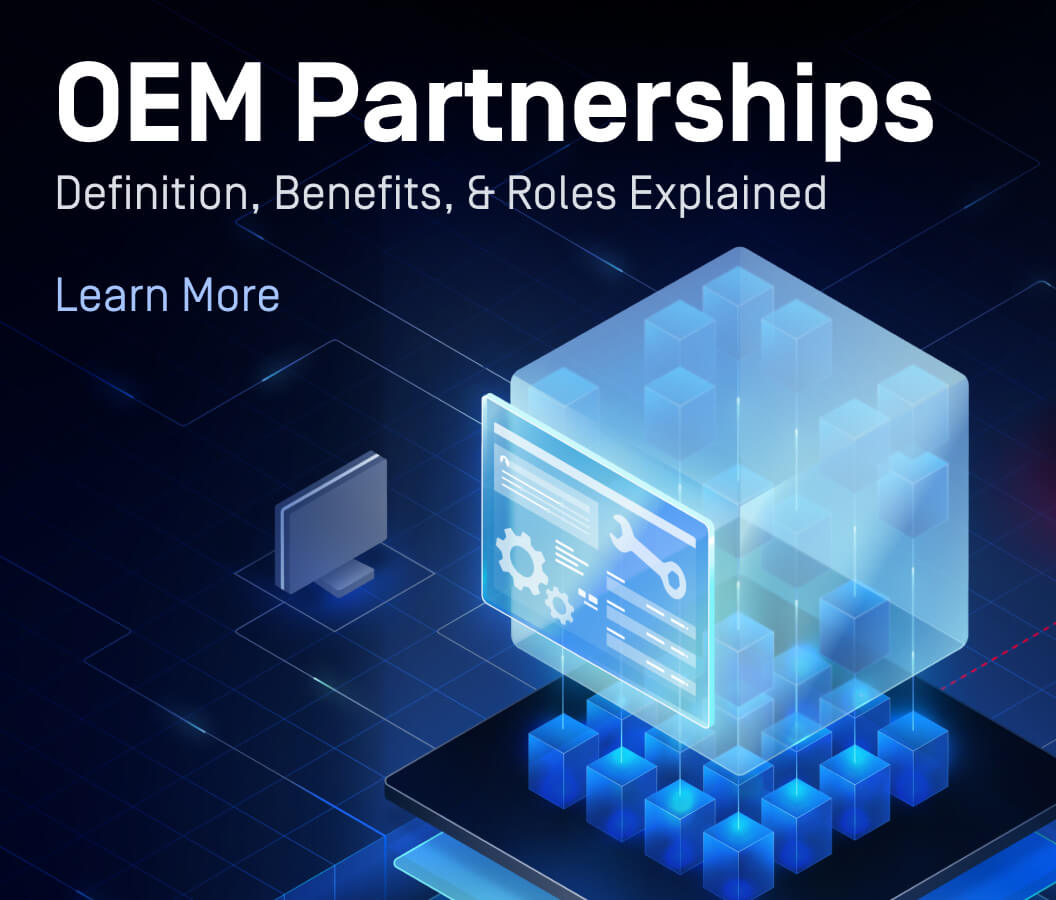What is an OEM Partner?
The answer to this question is two-fold as a partnership requires two parties:
- An OEM (Original Equipment Manufacturer) partner—or in this case a provider—is a company that manufactures products or components that are purchased by another company and sold under that purchasing company’s brand.
- On the other side, an OEM partner is also the OEM customer licensing the OEM’s products and/or services with the goal of incorporating them into their own products and/or services.
OEM partners are foundational in industries such as industrial manufacturing, cybersecurity, and software, where high-quality, scalable production and deep technical integration are essential.
OEM partnerships support critical functions like product integration, rapid go-to-market strategies, and strong supply chain performance. Unlike other models, OEM partners typically focus on production and backend integration rather than customer-facing services.
What does OEM stand for?
OEM stands for Original Equipment Manufacturer. In practice, this refers to a company that builds hardware, software, or components that are incorporated into another company’s branded offering.
What does “OEM partner” mean?
An OEM partner supplies components or complete systems that are integrated into a broader product or service and branded by the purchasing company. OEM partners enable scale, speed, and strategic capability within complex supply chains.
For example, a cybersecurity software vendor might partner with an OEM to embed advanced malware detection engines into their platform—delivering powerful protection under their own brand without building the technology from scratch.
What’s an OEM?
An OEM is a specialized manufacturer that produces parts or systems used by other companies. These manufacturers do not typically engage directly with end users but play a vital role in product development and delivery.
For example, a company that manufactures the touchscreen used in a smartphone might be the OEM—even though the phone is sold under a different brand.
How Do OEM Partnerships Work?
OEM Business Model Explained
The OEM business model revolves around creating high-quality components or systems that are embedded into another brand’s offerings. Revenue is driven by bulk orders, licensing, or embedded technology agreements—especially relevant in sectors like cybersecurity, where OPSWAT provides technology integrations through its OEM partner program.
Product Integration and Customization
OEMs work closely with partners to integrate technology, often offering customization options to meet industry-specific requirements.
Benefits of OEM Partnerships
OEM partnerships deliver key advantages for both parties:
Cost Efficiency
Partners reduce COGs and avoid the overhead of manufacturing or R&D.
Speed to Market
Leverage existing technology to launch faster.
Access to Expertise
OEMs bring domain-specific capabilities.
Scalability
What’s the Importance of OEMs?
OEMs enable businesses to expand offerings and maintain compliance by providing vetted, secure components—especially valuable in industries like defense, energy, and government where OPSWAT partners embed our cross-domain solutions to enforce secure data transfer.
OEM Provider Roles
An OEM provider typically oversees the following:
Product Manufacturing
Delivers reliable, scalable hardware or software.
Quality Assurance
Meets strict industry and regulatory standards.
Technical Support
What is the role of an OEM provider?
The OEM partner provides the foundational technology that becomes part of a broader solution. In cybersecurity, this can mean providing the scanning, sanitization, or threat intelligence engines that power a secure file transfer product.
OEM Partnerships vs. Other Partnership Models
Understanding the difference between OEM partnerships and other models helps businesses select the right approach.
| OEM | VAR | Use Case | |
|---|---|---|---|
| OEM vs. Value-Added Reseller (VAR) | Provides the base technology or product. | Resells with additional services, like configuration or support. | Choose OEM for backend integration; choose VAR for customer-facing delivery. |
| OEM vs. White Label Partnerships | Often co-branded or tightly integrated. | Completely rebranded and often generic. | OEM is ideal when technical differentiation matters. |
| OEM vs. Integration Partners | Supplies core components or engines. | Connects systems or tools. | Use OEMs for building blocks, integrators for workflows. |
Managing OEM Partnerships: Best Practices
Partner Relationship Management Tools
Effective partner management relies on clear KPIs, SLAs, and collaboration tools. Using partner relationship management (PRM) solutions helps align roadmaps, manage deliverables, and scale the partnership over time.
At OPSWAT, we support partners through a dedicated team, integration engineering, and marketing enablement—all available via our partner portal.
OEM Partners in the Business Ecosystem
OEM partners are a critical part of today’s business ecosystems—especially in complex industries like critical infrastructure protection and defense. They support everything from embedded cybersecurity to supply chain visibility.
Building a Partner Network
A modern partner network may include OEMs, VARs, integrators, and resellers. OEMs are typically the foundation—enabling innovation at scale and empowering partners to offer differentiated solutions.
Ready to Partner?
OEM partnerships aren’t just about embedding technology—they’re about building something stronger, together. Whether you’re building a cybersecurity platform, device management system, or secure workflow tool, OPSWAT can help.
Frequently Asked Questions (FAQs)
Q: What’s the importance of OEMs?
A: OEMs deliver the core components that enable efficiency, scalability, and innovation across industries.
Q: What is an OEM provider?
A: An OEM provider manufactures products or components used by another company under its brand.
Q: What does OEM stand for?
A: OEM stands for Original Equipment Manufacturer. While it originally was focused entirely on hardware, the term today also applies to software.
Q: What is the role of an OEM partner?
A: The OEM partner manufactures, supports, and ensures the quality of integrated components or systems.
Q: What is the OEM business model?
A: OEMs generate revenue by producing goods for other companies to rebrand, resell, or integrate.

